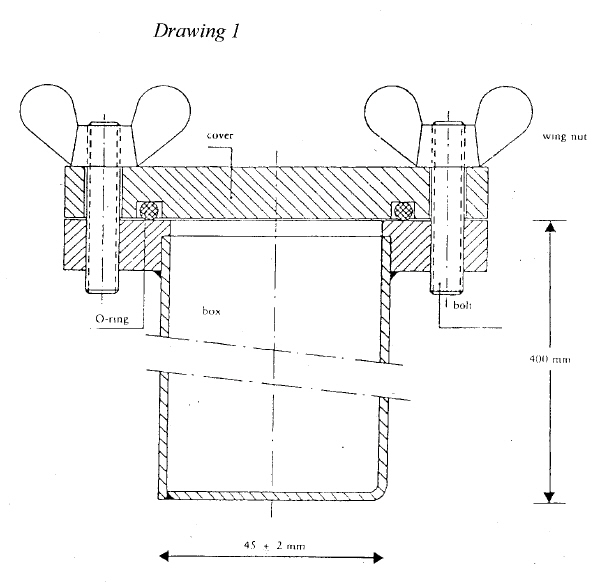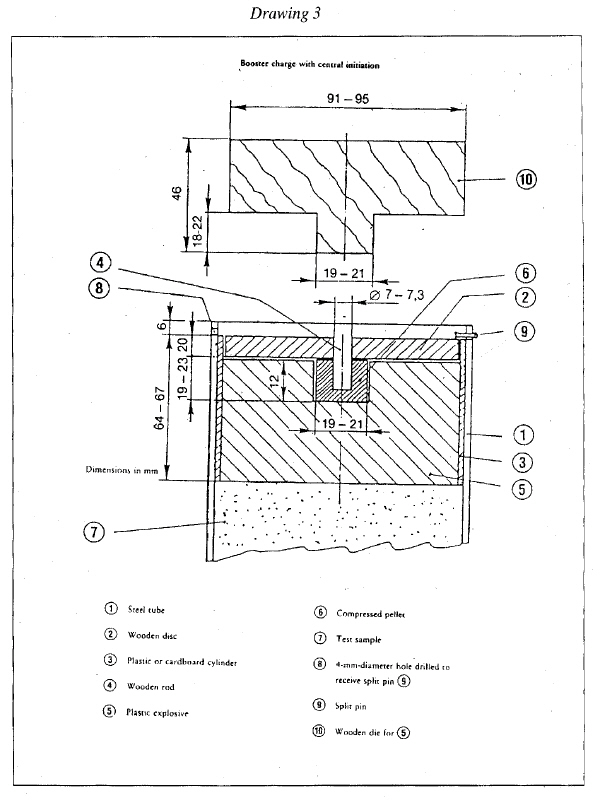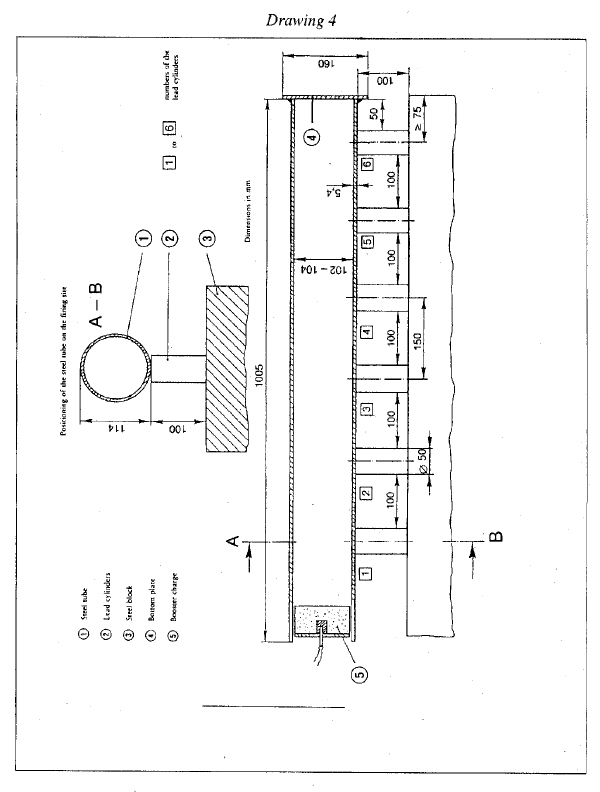- Latest available (Revised)
- Original (As made)
The Ammonium Nitrate Materials (High Nitrogen Content) Safety Regulations 2003
You are here:
- Show Geographical Extent(e.g. England, Wales, Scotland and Northern Ireland)
- Show Timeline of Changes
More Resources
Changes to legislation:
There are currently no known outstanding effects for the The Ammonium Nitrate Materials (High Nitrogen Content) Safety Regulations 2003, Paragraph 12.![]()
Changes to Legislation
Revised legislation carried on this site may not be fully up to date. At the current time any known changes or effects made by subsequent legislation have been applied to the text of the legislation you are viewing by the editorial team. Please see ‘Frequently Asked Questions’ for details regarding the timescales for which new effects are identified and recorded on this site.
12. Evaluation of test results.E+W+S
If, and only if, in each firing, the crushing of at least one lead cylinder is less than 5%, the sample shall be determined to be resistant to detonation. Otherwise it shall be determined to be not resistant to detonation.
Note 1: In so far as it is consistent with the procedures set down in [F1Annex 3 to Regulation (EC) No 2003/2003 of the European Parliament and of the Council relating to fertilisers] for the testing of straight ammonium nitrate fertilisers an alternative method in accordance with this note may be adopted for the application of thermal cycling—
(1) Principle and definition
Heat the sample from ambient temperature to 50 °C and maintain at this temperature for a period of one hour (phase at 50 °C). Then cool the sample until a temperature of 25 °C is achieved and maintain at that temperature for one hour (phase at 25 °C). The combination of the successive phases at 50 °C and 25 °C forms one thermal cycle. After being subjected to the required number of thermal cycles, the test sample is held at a temperature of 20 ± 3 °C pending the execution of the detonation test.
(2) Apparatus
Two different methods using ovens can be utilised for conditioning the test samples. Method 1 employs a single oven capable of being thermostatically controlled to temperatures of 50 °C and 25 °C and with a minimum heating and cooling rate of 10 °C/h. Method 2 employs 2 ovens, one thermostatically controlled to 50 °C and the other controlled to 25 °C.
(3) Procedure
(a)Divide approximately 20 kg of the sample of relevant ammonium nitrate material into eight roughly equal portions and place them in identical polythene bags made air-tight using a heat sealing device.
(b)Insert a suitable thermocouple into one of the portions through the wall of the polythene bag and tape it into place.
(c)Place the bags in an oven at 50 °C and once the thermocouple indicates that the portions have attained this temperature maintain them at that temperature for one hour.
(d)The bags must then either be removed from the oven and be placed in another oven at 25 °C (method 2) or the oven thermostat must be reset to 25 °C (method 1).
(e)Once the portions have cooled to 25 °C they must be maintained at that temperature for one hour.
(f)Repeat the thermal cycles four more times and then maintain the bags and their contents at a temperature of 20 ± 3 °C pending execution of the detonation tests.
(g)Discard the material from the bag containing the thermocouple and perform the detonation tests on the material from the other seven bags.
Note 2: In so far as it is consistent with the procedures set down in [F2Annex 3 to Regulation (EC) No 2003/2003 of the European Parliament and of the Council relating to fertilisers] for the testing of straight ammonium nitrate fertilisers an alternative plastic explosive may be used that contains 86% to 90% cyclonite, with a density of between 1,550 to 1,650 kg/ m3, and a detonation velocity of between 8,000 to 8,400 m/s, Mass 500 ± 1 gram.
Textual Amendments
F1Words in Sch. 2 para. 12 substituted (15.3.2019) by The Fertilisers and Ammonium Nitrate Material (Amendment) (EU Exit) Regulations 2019 (S.I. 2019/601), regs. 1(2), 3
F2Words in Sch. 2 para. 12 substituted (15.3.2019) by The Fertilisers and Ammonium Nitrate Material (Amendment) (EU Exit) Regulations 2019 (S.I. 2019/601), regs. 1(2), 3
Options/Help
Print Options
PrintThe Whole Instrument
PrintThe Whole Schedule
PrintThe Whole Part
PrintThis Section only
Legislation is available in different versions:
Latest Available (revised):The latest available updated version of the legislation incorporating changes made by subsequent legislation and applied by our editorial team. Changes we have not yet applied to the text, can be found in the ‘Changes to Legislation’ area.
Original (As Enacted or Made): The original version of the legislation as it stood when it was enacted or made. No changes have been applied to the text.
See additional information alongside the content
Geographical Extent: Indicates the geographical area that this provision applies to. For further information see ‘Frequently Asked Questions’.
Show Timeline of Changes: See how this legislation has or could change over time. Turning this feature on will show extra navigation options to go to these specific points in time. Return to the latest available version by using the controls above in the What Version box.
More Resources
Access essential accompanying documents and information for this legislation item from this tab. Dependent on the legislation item being viewed this may include:
- the original print PDF of the as enacted version that was used for the print copy
- lists of changes made by and/or affecting this legislation item
- confers power and blanket amendment details
- all formats of all associated documents
- correction slips
- links to related legislation and further information resources
Timeline of Changes
This timeline shows the different points in time where a change occurred. The dates will coincide with the earliest date on which the change (e.g an insertion, a repeal or a substitution) that was applied came into force. The first date in the timeline will usually be the earliest date when the provision came into force. In some cases the first date is 01/02/1991 (or for Northern Ireland legislation 01/01/2006). This date is our basedate. No versions before this date are available. For further information see the Editorial Practice Guide and Glossary under Help.
More Resources
Use this menu to access essential accompanying documents and information for this legislation item. Dependent on the legislation item being viewed this may include:
- the original print PDF of the as made version that was used for the print copy
- correction slips
Click 'View More' or select 'More Resources' tab for additional information including:
- lists of changes made by and/or affecting this legislation item
- confers power and blanket amendment details
- all formats of all associated documents
- links to related legislation and further information resources




